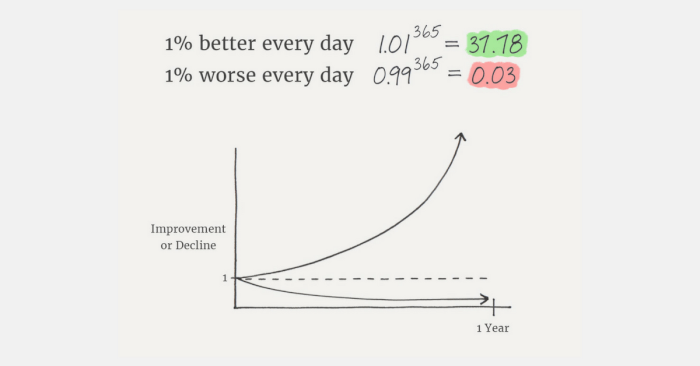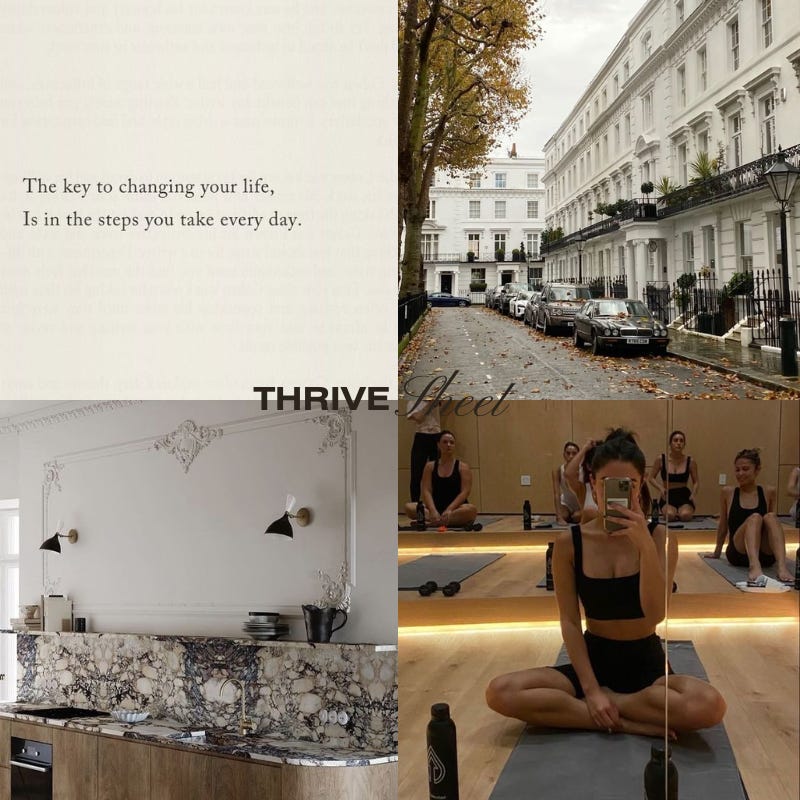This week’s:
Affirmation: Each day, I grow stronger, wiser, and closer to my goals with every small step forward
Quote: Success is the product of daily habits—not once-in-a-lifetime transformations. — James Clear, Atomic Habits
The 1% Rule: The Power of Small, Consistent Gains
In a world that loves big wins and overnight success stories, it’s easy to overlook the power of small, incremental improvements. The 1% Rule suggests that getting just 1% better each day may not seem like much, but over time, these small changes compound into remarkable transformations. The beauty of this rule lies in its simplicity and accessibility: anyone, in any area of life, can work toward becoming just a little bit better every day.
The Power of Compound Growth
If you’ve read Atomic Habits by James Clear, you’re most likely familiar with this concept. In Atomic Habits, Clear illustrates how powerful small gains can be. He explains that if you can improve by just 1% every day for a year, you'll become 37 times better by the year’s end. Conversely, if you decline by 1% each day, you nearly diminish to zero. This idea is often compared to compound interest in finance: small, consistent gains compound over time, eventually creating substantial growth. Warren Buffett famously emphasised the same concept in building wealth, noting, “That’s how knowledge works. It builds up like compound interest.”

The 1% Rule shifts our focus away from life-changing moments and towards the small, steady actions that truly drive progress. It’s a call to rethink our desire for defining moments and dramatic shifts, urging us instead to respect and value the daily steps forward that often go unnoticed.
Imagine a pilot setting out on a flight from Los Angeles to New York. If they adjust their course by just a few degrees, it may not seem like much in the beginning. However, over the long flight, this small deviation would result in a totally different destination — landing in Washington D.C., for instance, instead of New York. In our lives, small, consistent changes in our actions and mindset can lead to completely different outcomes over time. Every small step, however seemingly insignificant, nudges us closer to or farther from our goals.
Habit Formation and The 1% Rule
As Aristotle famously stated, “We are what we repeatedly do. Excellence, then, is not an act, but a habit.” Building habits around the 1% Rule shifts the focus from achieving a single big result to mastering the small, repeated actions that produce progress. Every time you make a small improvement — like reading an extra page each day, doing an additional set of exercises, or spending a few extra minutes practising a skill — you’re reinforcing that habit, embedding it more deeply in your life, and making excellence more a part of who you are.
It’s this focus on habits that allows us to break through what Clear calls the plateau of latent potential. Many people give up when they don’t see immediate results, but those who stick with their small improvements break through this plateau. To others, it often looks like sudden success, but it’s simply the result of compounding progress over time.
Applying the 1% Rule in Your Life
The 1% Rule can apply to almost any area of your life. Here are some ways to start integrating it:
Physical Health: Instead of aiming for a complete body transformation overnight, start by adding a minute or two to your daily workout, a few extra steps, or an additional glass of water. These small actions accumulate, creating noticeable improvements in the long run.
Career and Skills: In any profession, learning never stops. Committing to reading a page from a book, learning a new term, or practising a new skill daily can set you on a path of exponential growth over time. This is often how top professionals reach their peak – through consistent learning and practice.
Relationships: Small gestures, like checking in with loved ones, giving genuine compliments, or expressing gratitude, can transform relationships over time. These actions may seem small, but they foster strong connections and build lasting bonds.
Mental Health: Personal growth often requires introspection and self-compassion. Practices like mindfulness, meditation, or gratitude journaling might not show immediate results, but they build resilience, calm, and happiness over time. Think of it as mental fitness, where daily, small efforts can make a significant impact.
Key Takeaways from the 1% Rule
Focus on Small Steps: Often, we overestimate the importance of a single defining moment and underestimate the power of small, consistent actions. The 1% Rule reminds us that every small step forward is valuable.
Embrace Consistency: Building consistency is the real key to growth. Whether in personal habits, career growth, or health, consistency unlocks transformation.
Celebrate Small Wins: Progress isn't always about grand achievements; it’s about the cumulative power of small wins. Celebrating each small improvement can keep you motivated and help you appreciate the journey.
Break Through the Plateau: There may be times when progress seems slow or even invisible, but this “plateau of latent potential” is natural. Small, persistent efforts eventually lead to big breakthroughs that others might see as “overnight success.”
The 1% Rule is a gentle reminder that progress is within reach. We don’t need to wait for a major opportunity or a huge change to get better. Instead, we can start today, making small adjustments that add up over time.
So, the next time you think of change as daunting or overwhelming, remember the 1% Rule: it’s the tiny, consistent improvements that create lasting success and help us reach our full potential.
ICYMI
VC
BBG Ventures raises new $60M fund to support diverse founders. (TechCrunch)
Female Founders Fund returns its Fund I. (TechCrunch)
Startups
Canva, cofounded and led by Melanie Perkins, valuation increased to $32 billion following a share sale. Did you know that she got over 100 rejections from venture capitalists? Talk about persistence. Read more about the founding journey of Canva below. (Startup Daily)
Research Grid founded by Amber Hill raises $6.48M to automate clinical trial admin. (TechCrunch)
Consumer
Moncler is reportedly considering a bid for Burberry. (Reuters)
Blackstone in advanced talks to acquire shopping center owner Retail Opportunity. (Reuters)
Canadian fast-fashion retailer Groupe Dynamite hires bankers for IPO. (Yahoo Finance)
E.l.f. Beauty lifts annual forecasts on resilient cosmetics demand. (Reuters) While competitor Coty sees annual profit at low end of forecast. (Reuters)
How Gen Z fell for Glossier’s new perfume without ever smelling it. (WSJ)
Tech
AI models replace real people in Mango’s ads. (New York Post)
Sophia Velastegui believes AI is moving too fast. (TechCrunch)
OpenAI acquires the domain chat.com. (TechCrunch)
Melanie Perkins and The Founding Story of Canva
Melanie Perkins’ journey with Canva is a story of grit, insight, and a clear vision for accessible design. As a student at the University of Western Australia, she noticed that most design software required extensive training and costly licenses, which were barriers for many users. Recognising a need for a simpler approach, she co-founded Fusion Books, a platform for students to design their own yearbooks, giving her an initial foothold into digital design. Fusion Books was a success, validating her idea that a streamlined design tool was highly marketable.
This experience inspired Perkins to create a universal design platform that would make graphic design easy and affordable for everyone. She envisioned a tool that could be used by anyone, regardless of skill level. But when it came to securing funding, her idea wasn’t initially embraced. Perkins was rejected by more than 100 venture capitalists who doubted the potential for an accessible online design platform. Despite these setbacks, Perkins remained committed, believing that democratising design would ultimately be revolutionary.
In her journey to bring Canva to life, Perkins connected with Silicon Valley investor Bill Tai, who recognised her dedication and introduced her to a valuable network. Through these connections, she met Cameron Adams, a former Google engineer, who joined her as a co-founder and brought technical expertise to the project.
When Canva launched in 2013, it gained momentum quickly, attracting 750,000 users within its first year. Today, Canva boasts millions of users worldwide and has grown into a multi-billion dollar company.
Key Takeaways:
Turn Frustration into Innovation Perkins' idea for Canva emerged from her own frustration with complex design software, showcasing the power of spotting and addressing a gap in the market.
Resilience Through Rejection Her perseverance through 100+ rejections from investors highlights the importance of commitment and confidence in one’s vision.
Build a Strong Network Strategic networking helped her gain access to resources, advice, and connections essential for turning Canva into a reality.
Validation of Concept Starting with Fusion Books allowed Perkins to test her concept on a smaller scale, proving its potential before fully launching Canva.
Universal Design Perkins' goal of creating a design tool for everyone was key to Canva’s success, emphasising the power of inclusivity in product design.
Thank you so much for reading Thrive Sheet. I would love to hear from you—reply to this email or connect with me on social media; Instagram; TikTok; Twitter; LinkedIn.






